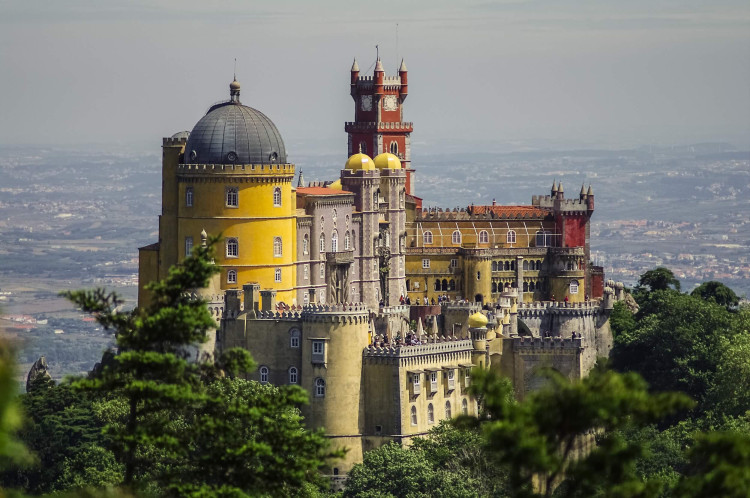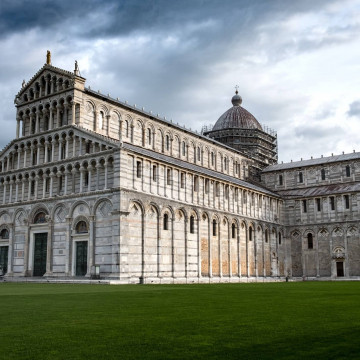Pałac Pena in Sintra (Portugal) - fairytale palace near Lisbon
Where is located Pena National Palace in Sintra?
Address of Pena National Palace in Sintra is Estrada da Pena, 2710-609 Sintra, Portugal
show on map
When was built Pena National Palace in Sintra?
Built date of Pena National Palace in Sintra is 1838 - reconstruction of the monastery
1842 - 1854 - construction of the palace

Facts, informations and history of Pena National Palace in Sintra
Initially on this hill there was a chapel dedicated to Our Lady of Penens.
Legend has it that while hunting on a mountain top, King Manuel I noticed Vasco da Gama's fleet entering the Tagus River returning from a pioneer sea voyage to India. In the same place where the chapel stood, the king decided to build a monastery, recognizing the navigator's outstanding achievement.
The fifteenth-century Hieronymit Monastery built here burned down largely from a lightning strike in 1743, and a moment later, in 1755, it was almost completely destroyed by the great earthquake ground. The chapel itself survived almost intact.
The ruins remained in this state until the nineteenth century, when the construction and decoration of the palace were initiated by King Ferdinand II and Queen Maria II. The palace was to serve as a summer residence for the Portuguese royal family.
The palace was a gift from the king to Queen Maria II, but she died in 1853, so the couple never lived together in the palace.
The execution was done by the German baron Wilhelm von Eschweg, but he did not have an architectural background, which is why he designed something very diverse. This is evidenced by tiny balconies, colorful towers and domes, sculptures of dragons and sirens as well as tiles with a wide range of themes. Yellow, purple and pink pastel colors complement the fairy-tale character of the palace.
The palace represents a mixture of Neo-Gothic, Neoman-Neurian, Neo-Roman and Neo-Renaissance styles. Muslim and medieval elements, arch arches and a decorative window in the main façade were proposed by the king himself.
The outer part is decorated with allegorical sculptures referring to biblical stories and religious icons and richly painted Portuguese tiles.
The interiors of the palace are decorated with painted rooms, multi-colored columns, arched ceilings and decorative stucco work. Many rooms have been designed to reflect a certain cultural impact, ranging from the Middle East to the Baroque European.
In 1889 Pena was bought by the Portuguese state, and after the Republican Revolution of 1910 it was classified as a national monument and transformed into a museum.
In 1910 the palace and its nearby grounds were abandoned and fell into ruin after the royal family fled Portugal after the revolution. The area was restored at the end of the 20th century. Many state rooms have been restored to their state in 1910.
The entire palace complex can be divided into four parts:
1) foundations and surrounding walls with two entry gates and a drawbridge;
2) restored structure of the old monastery with a clock tower;
3) courtyard in front of the chapel with a wall of mauric arches;
4) palace area and cylindrical bastion with cathedral style interiors.
Many fragments of original buildings have survived among the ruins, including monastery dining room, sacristy and chapel. They were surrounded by a wide terrace.
The gardens around the palace occupy an area of 5 hectares. The wooded area with many lakes and gazebos has many wide paths and winding lanes. Park Pena itself covers an area of 200 hectares. At the behest of the king, vegetation from four corners of the world was brought here, including more than 500 kinds of trees.
Pena Palace was inscribed on the UNESCO World Heritage List in 1995 and was also considered one of the seven wonders of Portugal. In 2015, he was recognized as the most beautiful palace in the world in the international competition European Best Destination.
On a cloudless day Pena Palace is visible to the naked eye from Lisbon more than 25 kilometers away.
Architect of Pena National Palace in Sintra

Construction/building type
Building Pena National Palace in Sintra is of type Palace
Architectural style
Architectural style of Pena National Palace in Sintra is Neogotyk, Neo-Renaissance, Romanticism, Moorish revival, Neomanuelin
Neo-Gothic is an architectural style that emerged in Europe in the 19th century and inspired many buildings, both public and private. Its name comes from Gothic, which was one of the most important architectural styles of the Middle Ages. Neo-Gothic was designed to recreate the look and feel of medieval Gothic buildings. ... czytaj więcej.
What material is the building made of?
Pena National Palace in Sintra is made of the following materials: Marble
Other names
The building is also known by other common names or in the original language, i.e. Palacio Nacional da Pena
Is the building on the UNESCO World Heritage List?

The listing took place in the year 1995.
Details of the entry are available on the Unesco website at https://whc.unesco.org/en/list/723/
Photo gallery Add photo
Location on map / How to get there




























Comments to Pena National Palace in Sintra (2) Average rating: 5 Add comment / Rate building
Based on 2 comments